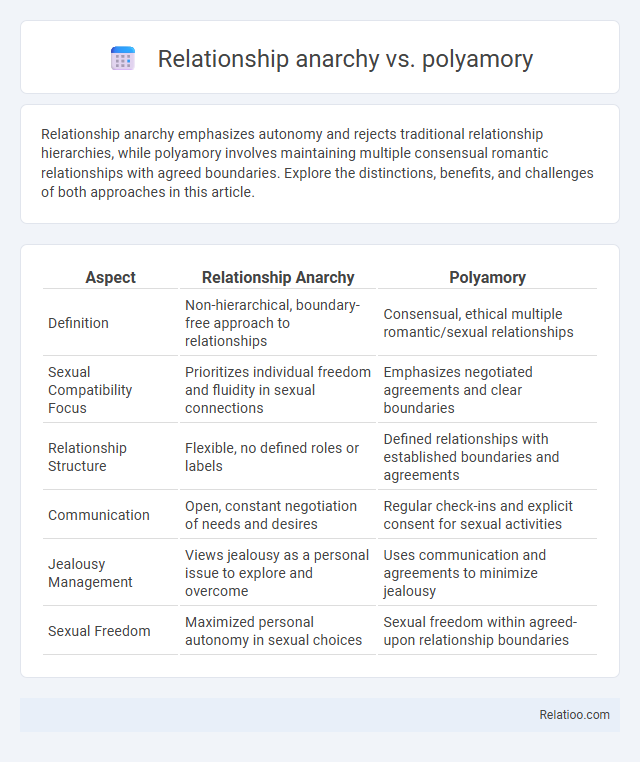Relationship anarchy emphasizes autonomy and rejects traditional relationship hierarchies, while polyamory involves maintaining multiple consensual romantic relationships with agreed boundaries. Explore the distinctions, benefits, and challenges of both approaches in this article.
Table of Comparison
| Aspect | Relationship Anarchy | Polyamory |
|---|---|---|
| Definition | Non-hierarchical, boundary-free approach to relationships | Consensual, ethical multiple romantic/sexual relationships |
| Sexual Compatibility Focus | Prioritizes individual freedom and fluidity in sexual connections | Emphasizes negotiated agreements and clear boundaries |
| Relationship Structure | Flexible, no defined roles or labels | Defined relationships with established boundaries and agreements |
| Communication | Open, constant negotiation of needs and desires | Regular check-ins and explicit consent for sexual activities |
| Jealousy Management | Views jealousy as a personal issue to explore and overcome | Uses communication and agreements to minimize jealousy |
| Sexual Freedom | Maximized personal autonomy in sexual choices | Sexual freedom within agreed-upon relationship boundaries |
Defining Relationship Anarchy
Relationship Anarchy rejects traditional relationship norms by emphasizing personal autonomy, fluid boundaries, and the freedom to define connections individually without hierarchy. Unlike polyamory, which often involves having multiple romantic relationships with some structure or agreements, relationship anarchy prioritizes the deconstruction of societal rules around love and commitment. Consensual non-monogamy is a broader category encompassing various non-exclusive relationship styles, but relationship anarchy uniquely centers on dismantling conventional relationship expectations entirely.
Core Principles of Polyamory
Polyamory centers on the core principle of forming multiple consensual, loving relationships with transparency and honest communication among all parties involved. Unlike Relationship Anarchy, which rejects traditional relationship hierarchies and labels to prioritize individual autonomy, polyamory often maintains defined emotional connections and relationship agreements. Consensual non-monogamy serves as an umbrella term encompassing both polyamory and other non-exclusive relationship structures, all grounded in negotiated consent and ethical treatment of partners.
Key Differences Between Relationship Anarchy and Polyamory
Relationship Anarchy rejects traditional relationship hierarchies and labels, emphasizing fluid, autonomous connections without predefined structures, while polyamory typically involves multiple romantic relationships with agreed-upon boundaries and often includes hierarchical distinctions such as primary and secondary partners. Your understanding of relationship styles is deepened by recognizing that consensual non-monogamy serves as an umbrella term encompassing both relationship anarchy and polyamory, along with other ethical non-monogamous arrangements. Core to Relationship Anarchy is complete freedom from societal norms and agreements, contrasting with polyamory's emphasis on negotiation and consent within defined romantic partnerships.
Hierarchies in Relationships: RA vs. Polyamory
Relationship Anarchy (RA) challenges traditional hierarchies by rejecting predefined roles and prioritizing individual autonomy, while Polyamory often involves structured hierarchies such as primary and secondary partners. Your understanding of Consensual Non-Monogamy (CNM) broadens when comparing these models, as CNM encompasses various practices but does not inherently reject relational hierarchies like RA does. Exploring these differences helps you navigate which framework aligns best with your personal values around autonomy and connection.
Communication Styles and Boundaries
Relationship anarchy emphasizes fluid communication and flexible boundaries, allowing partners to define connections without traditional labels. Polyamory relies on clear, ongoing dialogues to manage multiple romantic relationships, establishing boundaries tailored to each partnership's needs. Consensual non-monogamy prioritizes transparent communication and negotiated limits to ensure mutual respect and consent across all involved individuals.
Jealousy Management in Both Models
Relationship anarchy, polyamory, and consensual non-monogamy each approach jealousy management through distinct frameworks focused on open communication, trust, and boundary-setting. In polyamory, you navigate jealousy by prioritizing emotional honesty and negotiated agreements among partners, while relationship anarchy encourages flexible, non-hierarchical connections that deconstruct traditional jealousy triggers by emphasizing autonomy and mutual respect. Consensual non-monogamy broadly supports managing jealousy by establishing clear consent and regular check-ins, allowing individuals to address insecurities and strengthen emotional resilience across all relationship structures.
Societal Perceptions and Misconceptions
Societal perceptions of Relationship Anarchy often confuse it with polyamory and consensual non-monogamy, despite its emphasis on individualized, non-hierarchical connections that challenge traditional relationship norms. Polyamory is frequently misunderstood as synonymous with promiscuity, although it centers on consensual multiple emotional and romantic bonds, while consensual non-monogamy broadly encompasses any agreed-upon romantic or sexual relationships outside exclusivity. Your exploration of these relationship styles requires awareness of common misconceptions that can lead to stigma, such as false assumptions about jealousy, commitment, and sexual ethics.
Overlapping Values and Shared Ideals
Relationship Anarchy, Polyamory, and Consensual Non-Monogamy all emphasize autonomy, honesty, and open communication as core values, fostering genuine connections without rigid hierarchies or societal norms. Each approach prioritizes ethical transparency and mutual respect, allowing Your relationship structures to be fluid and tailored to individual desires and boundaries. Shared ideals of consent and emotional awareness create a foundation where trust and personal freedom coexist harmoniously.
Choosing What Works For You
Relationship anarchy emphasizes personal freedom and rejects traditional relationship hierarchies, allowing individuals to define their connections without societal constraints. Polyamory involves maintaining multiple loving, intimate relationships with the consent of everyone involved, prioritizing emotional bonds and transparency. Consensual non-monogamy includes various relationship structures like open relationships and swinging, requiring clear communication and mutual agreement to tailor dynamics that best fit individual needs and values.
Myths and Truths About Non-Monogamous Relationships
Relationship anarchy, polyamory, and consensual non-monogamy are often misunderstood, with myths suggesting they lack commitment or emotional depth. In reality, these relationship styles prioritize communication, consent, and individualized agreements, debunking the stereotype of exclusivity as the only path to trust. Studies show that many non-monogamous partners experience high relationship satisfaction and emotional intimacy, challenging the misconception that non-monogamy leads to instability or jealousy.

Infographic: Relationship Anarchy vs Polyamory
 relatioo.com
relatioo.com